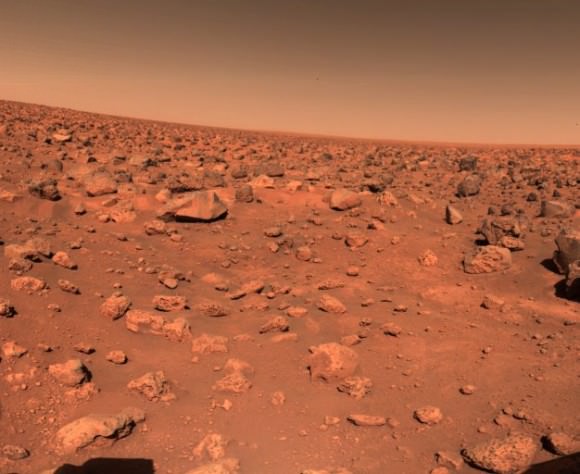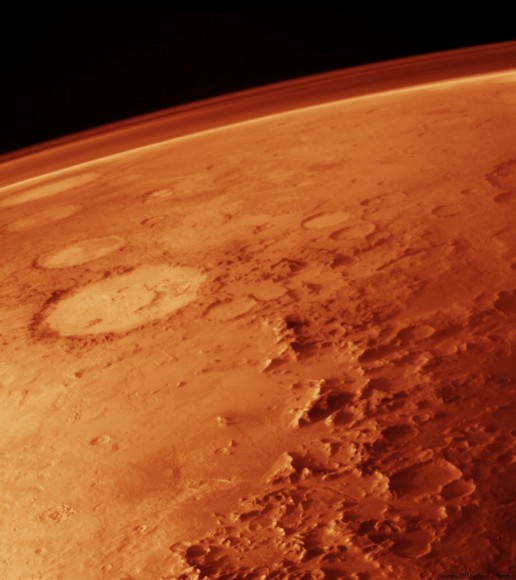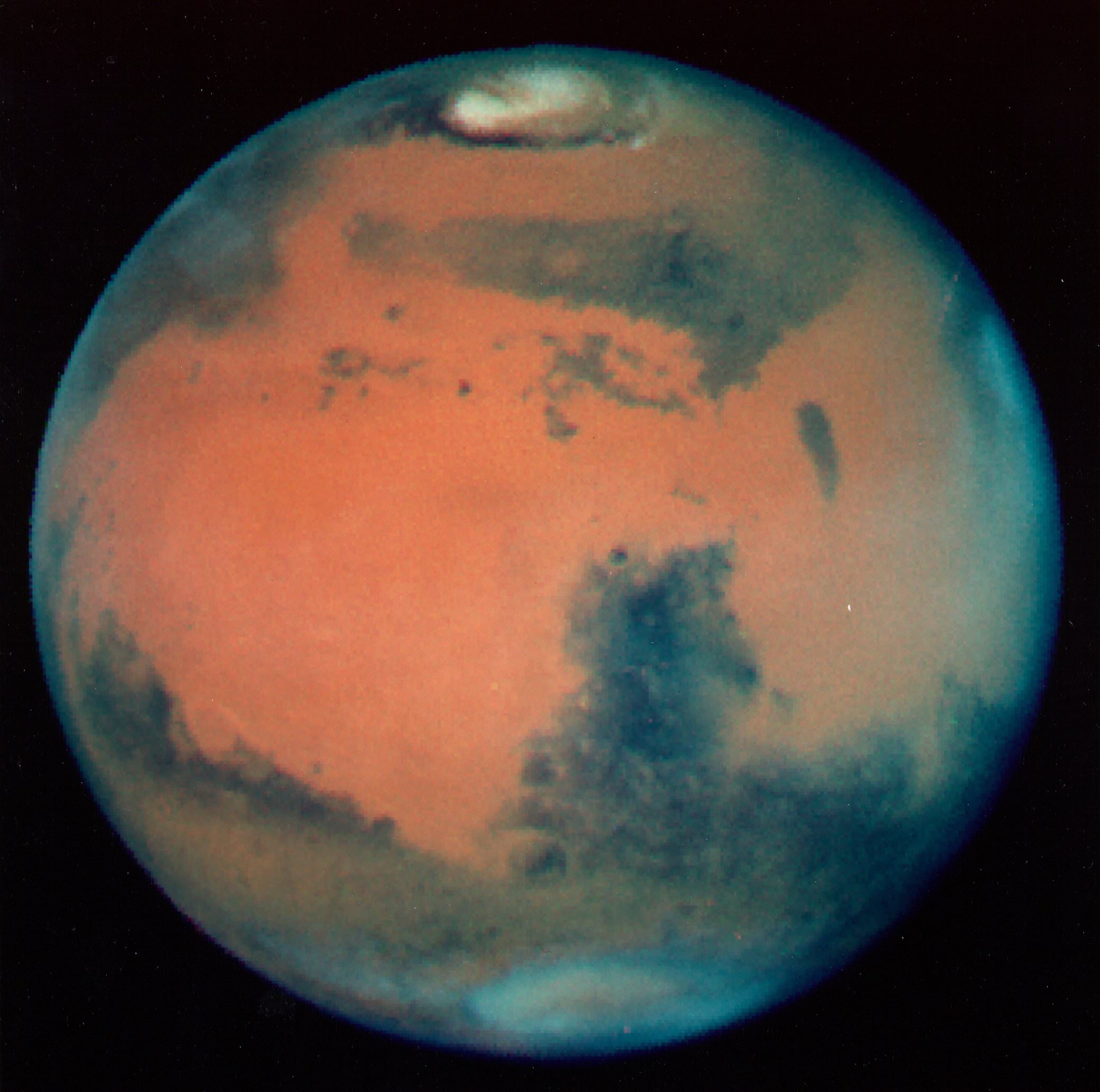[/caption]
Mars fever has gripped India. In a recent report from the Planetary Science and Exploration conference that was held in December 2011, scientists from the Indian Space Research Organization (ISRO) are making preliminary plans for a robotic mission to the Red Planet sometime next year.
The possibility of an Indian mission to Mars first came up during a brainstorming session at the Physical Research Laboratory (PRL), an affiliate of the ISRO, last March. For two days, scientists and students developed their plans and proposals for a mission to the red planet.
A Mars Mission Study Team has been established to review proposed scenarios for the future mission, and an Indian chapter of the Mars Society formed last year at IIT-Mumbai.

The report from the meeting last month gives a concrete look at what Indian scientists have on their Martian wish list. In all, ten instruments and experiments comprise the ultimate mission.
En route to Mars, a Mars Radiation Spectrometer (Maris) will measure and characterize background levels of charged particles in interplanetary space. This data will play a vital role in determining radiation levels facing humans going to Mars.
Once at Mars, the proposed Indian mission will focus on the Martian atmosphere.
A Probe For Infrared Spectroscopy for Mars (Prism) is designed to study the spatial and seasonal variations of atmospheric gases on Mars’ atmosphere throughout the mission’s lifetime. The Mars Exospheric Neutral Composition Analyzer (Menca) is designed to analyze the planet’s upper atmosphere-exosphere, the region roughly 400 km (248 miles) above the surface.
Specific instruments are designed to study the composition of the atmosphere. A Methane Sensor For Mars (MSM) has been proposed to detect traces of the gas in the atmosphere. Another instrument, Tis, will measure thermal emissions to help scientists generate a map reflecting the composition and mineralogy of the planet. It will also help the team monitor carbon dioxide levels.
A Plasma and Current Experiment (Pace) will assess the escape rate of the atmosphere and the structure of the “tail” this escaping atmosphere creates. Radio and microwave instruments will also be on board the spacecraft to measure the planet’s surface activity. A suite of instruments will also be on hand to detect plasma waves in the atmosphere.

Visual measurements are also part of the proposed mission. The Mars Color Camera (MCC) is designed to photograph the Martian surface from a highly elliptical orbit, roughly 500 km by 80,000 km (310 miles by 49,700 miles). The camera will be able to take high resolution images of the topography of the surface and map the polar caps, both of which are expected to help scientists understand surface events like dust storms.
According to ISRO scientists, the proposed mission could launch as early as November 2013, which would have the spacecraft enter into orbit around Mars in September 2014. A launch so relatively soon is appealing to many Indian scientists, many of whom argue that a mission to Mars should take priority over a mission to the Moon.
After all, India has already reached the Moon with the successful Chandrayaan-2 spacecraft. Why not keep the momentum going and aim for a new and exciting target with the next mission?
Source: Asian Scientist


Isn’t this proposed mission almost identical to NASA’s MAVEN mission, also planned for a 2013 launch?
Maven seems much more focused on the ionosphere, with no visual imaging capacity. It has an imaging UV spectrometer, but this is likely focused on the upper atmosphere unlike the proposed Indian mission’s IR spectrometer. There does seem to be some overlap between the radiation measuring equipment and possibly the exosphere composition packages. This seems like a pretty ambitious mission to be planning on such a short time frame, so these seem like some areas they might think about cutting. The remaining instruments seem more like the focus of ESA’s trace gas orbiter to be launched in 2016, so if they can’t launch during the next window the whole mission might become redundant.
ISRO should aim for Phobos, and whip up a bit of competitive spirit with Russia 🙂
<3 Amy for posting this.
Finaly more countries are joining in on space exploration!
…and the only prescription is MORE TABLA
But seriously, I’m glad more countries taking on space exploration, excellent
This is awesome- always great to have probes at Mars!
Indians are lately obsessed with Moon and Mars exploration. And Isro wants to setup a lunar base, inflatable one would be better- I’d prefer my own camping gear.
@amy India hasn’t launched Chandrayaan-2 yet. You are talking about Chandrayaan-1, it was the first space probe to discover water molecules on the moon.
ISRO may aim for underground habitat making in Moon & Mars.
Way to go, but would it not be better to coordinate such missions with other efforts? To minimize cost and maximize efficiency and results should be the goal. The better coordination, the quicker mankind becomes a space-faring civilization, all of us!
Way to go India. Keep it up.
Such a lovely country spending more treasure on space and bombs when they should be like us here in the USA! We have solved all our social problems and have a low crime rate (when you discount the people in prison for Pot) And I am sure all the Religious factions are Four Square behind these Space initiatives.I believe the Indian People need some good old fashioned Republican leadership to guide them into the 21st century, and help them realize the potential of embracing the concept of the 1% leadership for their country. As it has certainly worked well here. With the 99% of the populace whole heartedly behind every bush in every park they can find, before being run off by jackbooted rent-a-cops wielding pepperspray. Sarcasm? Satire? Invective? Take your pick. By the way… The videos of that fat little pig with the pepperspray is what we want the rest of the world to think of us? Have we come to this?
Please do not bother to complain or put me down, as I am already so sorry for what I have written, and the need for me to write it. I am all for the exploration of Space, in every aspect. I just had to rant tonight because my heart aches for so much that is wrong in our society.
The only reason I can endure is: There is so much right in our World! It is the efforts of People around the World that with the help of us all, we just might be able to right the the path we are on.
WE understand 😉 (all of it)
Thank You Prof. Micheal O. Zimmermann! I do get carried away sometimes! It was late and I was angry…. well at a lot of things! Sometimes it feels good to vent online. I do watch every development in the exploration of Space, Manned, Robotic, and the spectacular work being done with telescopes of ever variety. I wasn’t really putting India down, but I think you know that.
Well stated. This is not the place to take this up but I MUST inform
of the new Bill Moyers program on PBS. Someone has finally given
expression to what I have been yearning to hear on ANY media for
years now. Finally someone with credibility has noted one
of the root causes of all that is wrong with our present situation.
And that is the granting of ‘individual constitutional rights’ to
corporations. This, more than anything else, has resulted in
the corrupt political system we enjoy.
See it here: http://billmoyers.com/
Why not countries coordinate and spend money together for such expedition. Should not be part of just one country….
I agree, I think that international cooperation in the exploration of Space.. Near and Far is the best way for our Race to reach out and endeavor to understand the Cosmos. I am old enough to remember the start of space exploration. Then it was mainly a race between the USSR and the USA. Over the decades a spirit of cooperation has developed between many countries around the world. Countries with differing goals, but with a dedication to science and the understanding of our place in the wonderful universe we inhabit. If we are ever to travel to the Stars, it will be as Humans, not a specific nationality. That will be our lasting legacy… That of Man looking outward.
Alas history has shown that, certainly as far as manned spaceflight is concerned, co-operation between countries kills the competitive drive needed to push the frontiers and speed up technological advancement. Nothing like a Space Race to push us to our limits!
Now, with regards to Astronomy, international collaboration is crucial.
I love the idea of mankind working as one common great force to push past the frontiers of space and explore further into the unknown, but I am just sadly not sure how realistic that is at the moment.
the world needs to focus on inventing a viable, portable, magnetic forcefield to protect against cosmic and solar radiation, then everything should follow….that is, for human exploration.
nice collection i like 2 read it …….inteesting article gud